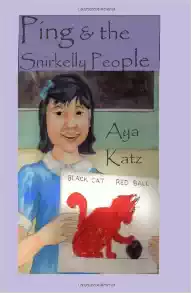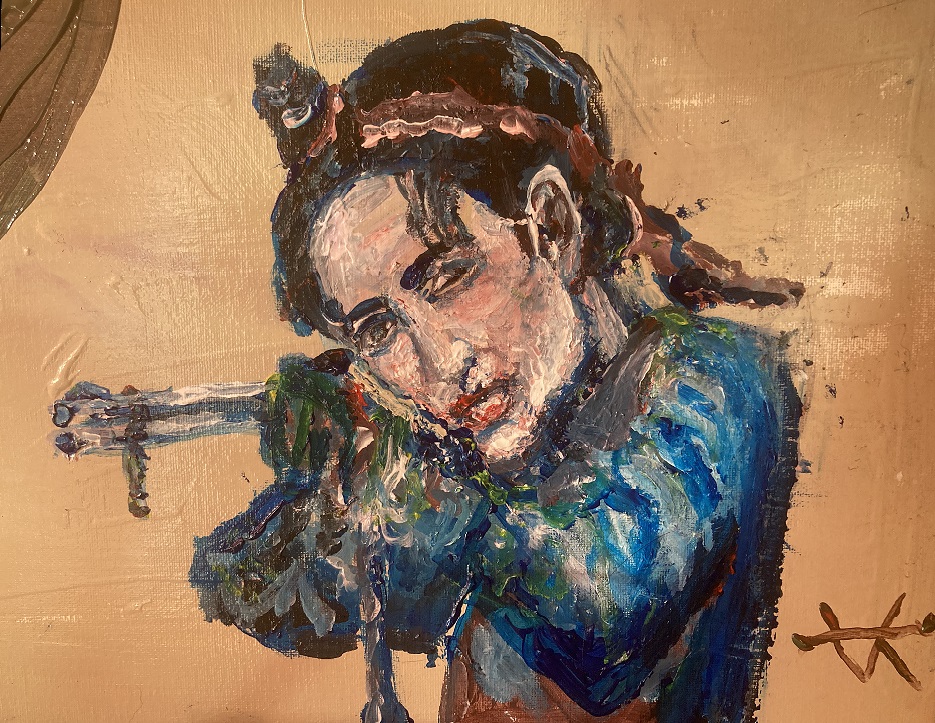In the United States the public school system is geared to help students of average intelligence, but above average hand eye coordination. In Israel, at the time when I was in kindergarten, the system was geared toward students with above average intelligence, but below average coordination skills. In this article, I will try to explain how this applies to art and learning how to draw and paint.
I am a self taught artist with below average hand-eye coordination skills. I compensate for what I can’t do with what I can. I believe that ultimately that is what all people have to do while making their way through life. Problems arise when school systems and employers are too fixated on the method and are less interested in the ultimate results.
In the above video, I share my painting method. As you can see, I do everything free hand, and there is no sketch of the figure on the canvas before the painting starts. As you can also see, the paint is not evenly distributed and there is no uniformity of brush strokes. As a result, you have a coherent image, but it is not very neat. I call this my messy painting style. But the truth is that I am not choosing this as a statement of style: it is my way of compensating for my disabilities by relying more heavily on my areas of strength. I believe that when teaching art to a diverse population of students, this method of compensation should be open to all who would profit from using it.
Some teachers believe that neatness has to be learned first, and for those students who are unable to learn neatness, they should be held back and prevented from executing complex representations until they can learn to be neat. But some of us never learn to be neat even after a lifetime of trying, though we are capable of higher order reasoning and representational painting.

My book Ping & the Snirkelly People Illustration by Lanie Frick
To demonstrate the difference between a conceptually friendly art teaching style and one that favors coordination skills over conceptual mastery, I will contrast my experience in an Israeli kindergarten in 1965 with the art teaching method I saw in a first grade class in the US in 1966.
In the Israeli kindergarten, our teacher asked us one day to draw a bird. She didn’t tell us how to draw the bird, leaving the choice of method entirely up to us. We had paper and crayons. The paper was entirely blank. We were left to our own devices in trying to figure out how to represent a bird.
The teacher looked over our work and praised those students whose representation of a bird looked most like a bird. She liked my drawing, and she even asked me to show another student how I drew the bird, because that student was having trouble drawing a bird.
The next year in the American first grade, we were given a paper that had a cat with a ball of yarn already drawn on it in outline. We were asked to use crayons to color it in, and we were told that the cat needed to be black and the yarn had to be red. We were then judged by how well we followed instructions and how neatly we colored the image. Because I did not understand English, I copied a fellow student who used the wrong colors, as she was bad at following directions. Because I have hand-eye coordination issues, my coloring was not neat. I was lucky that I had a good teacher who was kind and understanding.
However, when going from an Israeli method to an American method, the very same student can go from being “good at art” to being “poor in art”, because each method favors different skill sets.
Some art teachers reason that not everybody can draw freehand, but everyone can learn to color within the lines, to trace from a projector or to use a stencil. They argue that ultimately neat drawings, made using these methods, are better than freehand versions of the same image. What they don’t take into account is that not everyone will be able to color an outline in within the lines, trace the image correctly or use a stencil. Tracing, coloring and stencil use require good hand-eye coordination skills that not everybody has.
The reason I draw and paint freehand is not because I look down on tracing and stencils. It’s just that I could never master those skills after a lifetime of trying.
What art teachers can learn from my story is this: what is easy for one person is hard for another. For some students, drawing freehand is the only option that really works. It does not make sense to hold them back until they learn to color within the lines.
RELATED
https://www.pubwages.com/48/interview-by-julia-hanna-with-evelyn-adams-and-aya-katz



I think your readers would also like t9 know more about the type of writing that you used in your drawing of “a wonderful fish.”
😉
Hi, Kate. I think you are better qualified to explain that writing system, as I was only exposed to it during first grade, and never since then. But this would be wonderful topic for a PubWages article!
Sure, but the easiest and most interesting way for me to begin such an article would be by beginning with your comments (your child’s-eye view at the time) as a jumping-off point: You could start with your personal experiences, and then I would step in and discuss what was going on, and hen talk about the long history of similar systems used as experiments on schoolchildren. It would be easier for me to do it that way, and also more fun for me and for the readers, than to just launch into a straight lecture.
The truth is that at the time when I learned to read and write English in this novel method, I was not yet a speaker of the English language. I was learning so much in this experience of total immersion, that at first it did not even occur to me that the way we read and wrote English in class was different from the way people in the supermarket or the doctor’s office read and wrote English. I had hyperlexia, which means that reading came easily to me. Before I started to first grade in the US, I was already able to read and write Hebrew. The transition from the phonetic method taught at school to that standard spelling of American English was not too painful, because while I was in first grade my father enrolled me in the The Weekly Reader book club. I started reading books in normal English orthography. I did not always enjoy every book or understand all the words in it without looking them up, but I had no trouble at all with reading fluency. Here is a review I wrote fifty years after reading one of those books: https://www.amazon.com/gp/customer-reviews/R3LFPSHFJ3S4EF?ref=va_cr_lb
That is amazing and interesting! Maybe you’ll write a children’s book about it, one day, much as you have written at least one children’s book based on some of your other early school experiences.
Thanks, Kate. I actually left out the phonetic writing system they used from my description of my experiences in first grade in Ping & the Snirkelly People, because I wanted the book to be more universally understood. That was just one extra complication in the learning process, but I think it may have been more of a hindrance to the average English speaking first grader than it was for me. It is the same principle as why I didn’t notice how archaic the Spanish was in Cabeza de Vaca’s memoirs. It is not because I am excellent at reading Spanish, but because my Spanish is rusty, I can read an archaic book just as easily as a modern one.